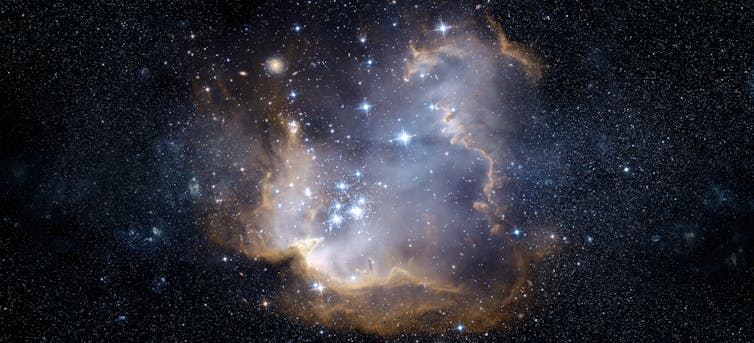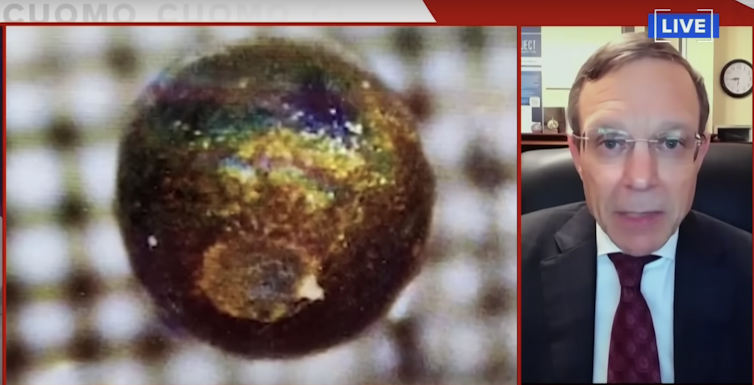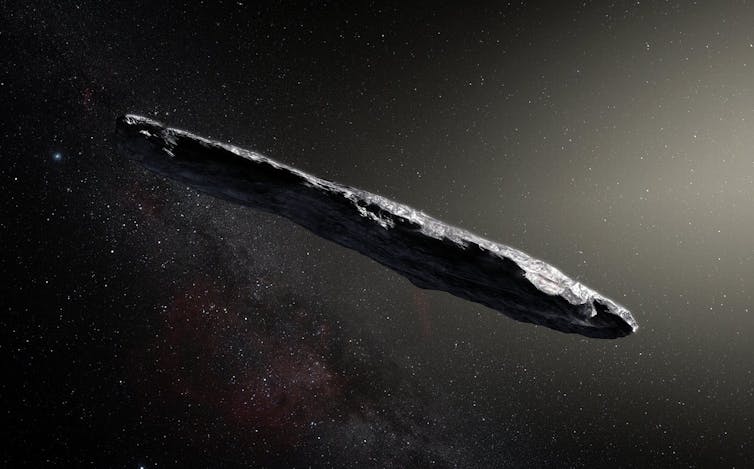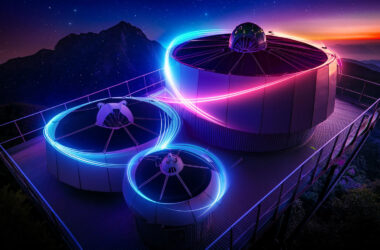Physicist who found spherical meteor fragments claims they may come from an alien spaceship – here’s what to make of it
Avi Loeb, a physicist from Harvard University in the US, has recovered 50 tiny spherical iron fragments from the bottom of the Pacific Ocean that he claims may be material from an interstellar alien spaceship.
 Anybody out there? Triff/Shutterstock, CC BY-SA
Anybody out there? Triff/Shutterstock, CC BY-SA
Loeb is linking his finding with the passage of a fireball in January 2014. The meteor was observed by sensors of the US Department of Defense that track all objects entering the Earth’s atmosphere. It was recorded as travelling faster than most meteors and eventually broke up over the South Pacific Ocean near Papua New Guinea.
Data on the object is held by Nasa’s Centre for Near Earth Object Studies (CNEOS). The meteor’s official name is CNEOS 20140108, and is also referred to as IM1 (for interstellar meteor).
 Loeb next to image of spherule. NewsNation/Youtube, CC BY-SA
Loeb next to image of spherule. NewsNation/Youtube, CC BY-SA
There is a very large scientific leap from observing a fireball to claiming it is an alien spaceship. What is the evidence on which Loeb bases the claim? And how likely is it to be true?
‘Oumuamua, an interstellar comet
We have already had at least one visitor from interstellar space – the comet ‘Oumuamua. The appearance of 1I/2017U1, the official name for ‘Oumuamua, was certainly an unusual event. The object was observed in 2017 as it was leaving the Solar System. Its trajectory is different from the near-circular orbits of the planets and elliptical orbits of comets.
The comet’s path was traced back, with scientists discovering that it had come from well beyond the outermost fringes of the Solar System. Scientists were excited but also intrigued – although its shape was not captured on camera, the way that light reflected from it as it rotated suggested that it had an odd shape like a cigar when viewed side-on or a plate when viewed from the top.
 ‘Oumuamua. ESO/M. Kornmesser, CC BY-SA
‘Oumuamua. ESO/M. Kornmesser, CC BY-SA
In a thoughtful article written in 2018, Loeb speculated that ‘Oumuamua might be artificial, rather than natural in origin – the product of an alien civilisation. He suggested that we should keep searching for interstellar debris in the Solar System.
In pursuit of such debris, Loeb’s team interrogated the CNEOS database, looking for objects with unusual orbital characteristics. That’s when they found CNEOS 20140108 and, based on its high velocity, suggested it was an interstellar meteor – giving it the more manageable name of IM1.
Modelling the path of the fireball, Loeb identified a specific area of the South Pacific where he believed debris from IM1 would be deposited. Following a dredging operation in the area with a powerful magnet, he now claims to have found material from IM1.
But what are the chances that he has found genuine interstellar debris at all, never mind a spaceship?
Cosmic spherules?
The metallic spherules that have been recovered are each about half a millimetre in diameter. It isn’t impossible for them to be of extraterrestrial origin: several previous expeditions have recovered spherules from space from the seabed.
The first expedition to find such samples was HMS Challenger in 1872-76. Material dredged from the ocean floor contained many metallic droplets, described at the time, quite accurately, as “cosmic spherules”. Droplets from space are spherical because they solidify from molten material torn from the surface of meteorites as they traverse the atmosphere.
Subsequent expeditions throughout the 20th century have also found cosmic spherules at the bottom of the ocean, but it has become harder to identify them. This is because, in the 150 years since the Challenger expedition, the amount of pollution has increased on Earth.
In 1872, the industrial revolution was in its infancy in Europe and practically non-existent in the southern hemisphere. Hence pollution such as “fly ash” (waste from burning coal) and particles from vehicles was minimal. Many of these pollutants are also spherical in appearance and metallic in composition.
Today, products from industrial processes and vehicles are everywhere. So, without an actual analysis of the composition of the spherules and a comparison with analyses of meteorites (and common terrestrial pollutants), it is not possible to identify any as extraterrestrial.
Interstellar?
But Loeb doesn’t just think the material is from space, he thinks it is from interstellar space – arguing “this could be the first time humans put their hands on interstellar material”.
This is simply not true. We have an abundance of interstellar material on Earth. Some of it is almost certainly on the ocean floor, but not in the form collected by Loeb.
The interstellar material to which I am referring comes in several different varieties. It is well known by astronomers that the interstellar medium – the space between stars – is not empty, but contains several different molecules, many of which are organic (made up of chains or rings of carbon). A portion of these molecules got mixed into the region of space where the Solar System was starting to form.
Stars themselves have also contributed material to the interstellar medium, as they evolved or exploded as supernovas. Some of this material comes as tiny diamonds or sapphires – rare mementoes of stars that lived and died before the Sun was born. These grains became part of the dust cloud that collapsed to form the Solar System, and were eventually carried to Earth in meteorites.
Alien spacecraft?
Loeb’s evidence for an extraterrestrial source for the material – never mind an interstellar origin – is rather shaky. He has found metallic spherules. For me (and many others) to accept that these spherules are extraterrestrial, I’d need firm analytical evidence. What is their composition? What is their age? Can we rule out terrestrial pollutants? Can we rule out debris from extraterrestrial material from within the Solar System?
The first question, about composition, has been answered: analysis of the spherules shows them to be mainly iron with a few trace metals.
We know meteors from our Solar System contain iron and nickel, echoing the relative abundances of these metals in the Sun. But the spherules apparently contain “negligible” amounts of nickel – thus indicating that they are almost certainly not from meteors within the Solar System. This does not, however, prove they are interstellar – it merely makes it more likely that they’re terrestrial pollutants.
The most convincing evidence would be to measure an age for the spherules greater than that of the Sun – which would identify them as interstellar.
And that would be amazing, but it would not necessarily identify them as having an artificial, rather than natural origin. I am not sure what evidence would be sufficiently convincing for this – maybe the autograph of the alien engineer who built the spacecraft?
Written by Monica Grady, Professor of Planetary and Space Sciences, The Open University and republished from The Conversation under a Creative Commons license.
- Avi Loeb, a physicist from Harvard University, has recovered 50 tiny spherical iron fragments from the Pacific Ocean that he suggests may be from an interstellar alien spaceship.
- The fragments are linked to a fireball observed in January 2014, which was recorded as travelling faster than most meteors and broke up over the South Pacific Ocean.
- Loeb’s claim is based on the high velocity of the meteor and the composition of the fragments, which are mainly iron with negligible amounts of nickel.
- However, without further analysis and comparison with meteorites and common terrestrial pollutants, it is not possible to definitively identify the fragments as extraterrestrial.
- While the fragments could potentially be from interstellar space, there is no concrete evidence to suggest they are from an alien spaceship.








